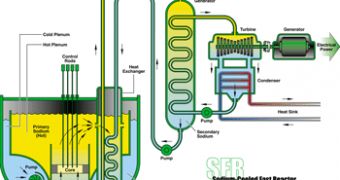The U.S Department of Energy has started a three-year project which will research the creation of a new generation of computers for a new kind of nuclear reactor, proposed by physics professor Michael Podowski. The reactor is called a sodium-cooled fast reactor, of SFR for short.
Nuclear reactors are mainly used in nuclear power plants to produce electrical energy, by 'burning' uranium into its core, through a reaction called nuclear fission, which splits uranium nuclei by bombarding them with neutrons, in the process resulting less heavier chemical elements, nuclear waste and a large amount of energy. The energy is collected in the form of head that is used to boil water and vaporize it to produce Steam, to power steam turbines which rotate electric generators and produce electric current.
Reactors are much cleaner than the other traditional methods that imply the burning of fossil fuel to produce heat, which produce large amounts of greenhouse gases and other byproducts dangerous to the environment. Nevertheless, the problem with nuclear reactors does not occur during the fuel 'burning', but after that, as the remnants of the reaction are highly radioactive and need special storage.
Nuclear reactors will become more widespread over the coming decades, as nations seek ways to fulfill their growing energy needs. SFR offers more power than the previous reactors, and in the private sectors, new projects are developing so-called "fourth generation" nuclear reactors, that will be safer and produce even smaller quantities of nuclear waste.
The SFR is a new design, with three stage heat exchange circuits. The heat from the reactor's core is drawn using liquid sodium, being continuously cycled by an electromagnetic pump, since an ordinary pump would not work in extremely hot sodium. The sodium will transmit heat from the first stage to the third intermediate stage through a heat exchanger; in the third stage, the mercury is being cycled. And finally, the third stage transmits heat to the second stage through which water is being pumped.
The SFR could have been designed with only three heat exchangers, but due to the high heat produced inside the core, scientists had to use liquid sodium to cool it down. The third stage has a protective role against any leaking sodium, as sodium and water produce a highly explosive reaction.
So as to understand even better the SFR, Podowski's team need to run extensive computer simulations to see how individual molecules of fission gas and fuel material interact with other molecules inside the reactor, and view the behavior of the reactor as a whole.
The project of creating a new type of supercomputer is conducted by Rensselaer Polytechnic Institute, has a funding of 3 million dollars to pair two of the world's most powerful supercomputers. The program is called "Deployment of a Suite of High Performance Computational Tools for Multiscale Multiphysics Simulation of Generation-IV Reactors", and partners include researchers form Columbia University, the State University of New York.

 14 DAY TRIAL //
14 DAY TRIAL //